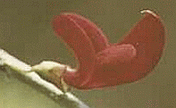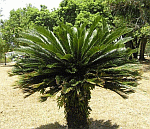
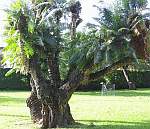
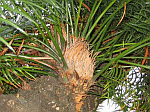
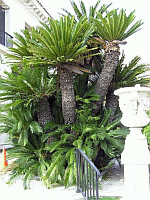
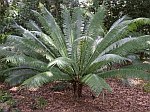
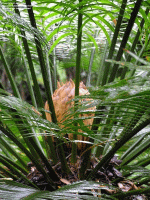
|
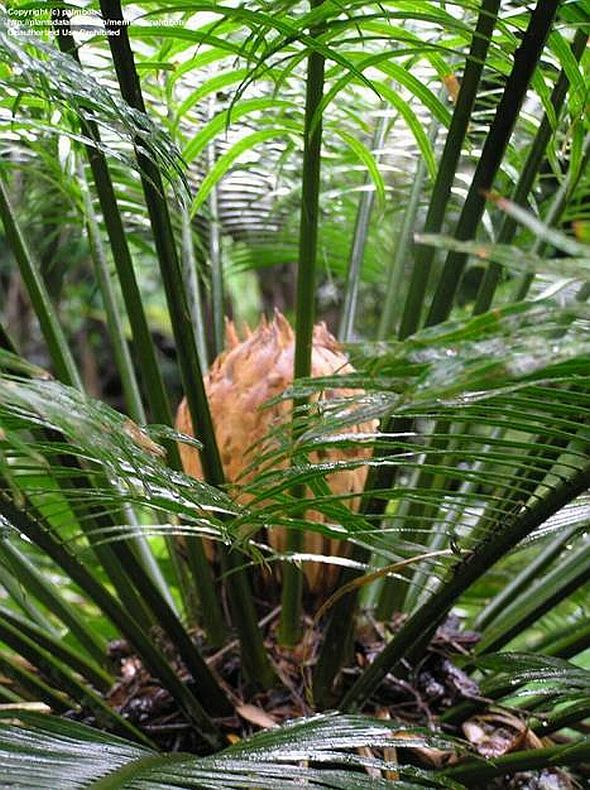
A young female cone, Cycas circinalis, California (Palmbob)
Plant Family: Sago Palms belong to the Cycadaceae or Cycad family; are not palms but cycads, an ancient group of slow growing seed plants with stout trunks and a crown of large, compound leaves; are dioecious, having separate male and female plants; females produce ovules and seed, and males produce cones with pollen; genus includes the larger, regal Queen Sago Palm (Cycas circinalis) and the smaller, more common King Sago Palm (Cycas revoluta).
Description: Sago Palms are very attractive trees, topped by a terminal crown of gracefully spreading, long, dark green, pinnate semi-glossy leaves; leaflets (pinnae) with prominent midrib without lateral veins; tomentum - the hairy leaf covering - sheds as leaf expands; male Sagos develop one or more elongated scale-like cones, coming from center of top of plant; female Sagos develop toothed, rounded, white or yellow cones, pollinated by insects or wind, and producing many flattened seeds; as cone matures, seed-bearing leaves separate displaying brightly colored seeds, often red, purple, or yellow; seeds have spongy layer allowing them to float on water. The much larger Queen Sago Palm usually consists of a single stout trunk up to 6 m tall (20 ft), 30-60 cm in diameter (1-2 ft); some branching may occur in older plants, producing handsome trees with multiple crowns; leaves 1.5-2.5 m long (5-8 ft), with 40 to 85 pairs of narrowly lanceolate leaflets with flat margins; male cones cylindrical, up to 70 cm tall (27 in); seeds yellow to brown, up to 5.5 cm long (2 in). The more common King Sago Palm is a smaller, “dwarf” species, growing up to 3.5 m (11 ft), developing many branches from the main trunk and from sprouts at ground level; has compact green leaves, 0.75-1.5 m long (2.5-5 ft); leaflets about 60 pairs, linear, 10 - 20 cm long (4-8 in), with thickened margins rolled under the leaf; male cones cylindrical, up to 50 cm tall (20 in); seeds red or orange, up to 4 cm long (1.5 in)
Natural Habitat: Queen Sago, typically occurs in fairly dense, seasonally dry, scrubby woodland in hilly areas of tropical Asia and Africa; King Sago found mainly on the sea shore in southern Japan; both species propagated by suckers or seed; seeds take from 6–18 months to germinat.
Origin and Distribution: Queen Sago native to tropical Africa and Asia, King Sago to southern Japan; today, only a handful of cycad species still exist, and many face extinction in wild, such as the Microcycas in western Cuba; but because of their large attractive leaves, cycads have found a home in public and private gardens around the world.
Uses: Primarily ornamental; often as focal point in large yards and public or private gardens; rosette pattern of feathery leaves add sense of tropics to landscape; young King Sago plants used as ornamental ground cover due to slow growth; flour can be made from seeds and pith of stem, but too much consumption may result in neurological disorder because of neurotoxin content; consumption is not recommended because of this toxicity and the endangered status of cycads; medicinally, various parts of the cycad plant used in treatment of cancer, malignant tumors, rheumatism and as a diuretic.
Indigenous Legends: Cycad is the Greek word for "palm" to which most cycads bear resemblance; Cycads are among oldest plants on earth, living as long as 2500 years; and they have been unchanged for millions of years.
References:
Jack Scheper. Plant Profile: Cycas circinalis. Floridata.com. Florida, 2004
Jack Scheper. Plant Profile: Cycas revoluta. Floridata.com. Florida, 2004
Anon. Official Guide to the Botanic Gardens, Dominica. Kew Gardens, London, 1924?
H.F. Macmillan. Tropical Planting and Gardening. Macmillan, London 1956
Alan Eyre. The Botanic Gardens of Jamaica. Andre Deutsch, London 1966
Plants for the Future. Hortiplex Plant Database, Florence, MA n.d.
US National Tropical Botanical Gardens, (ntbg.org). Kalaheo, Hawaii 2004
Robert A.DeFilipps. Useful Plants of the Commonwealth of Dominica, West Indies. Smithsonian Institution, Washington , D.C., 1998
|

